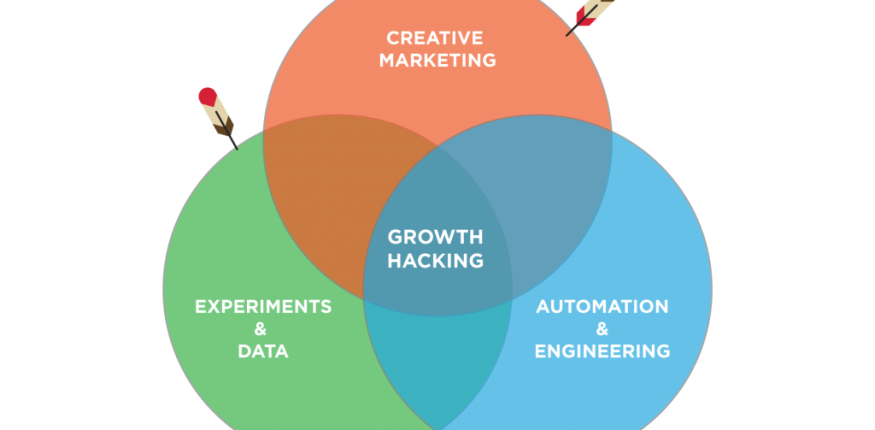
Do you have a clear-cut idea of why your idea is different from others? Can you show a tangible point like time, money, speed, pleasure, etc? If you just install an analytics tool, without a philosophy on what growth hacking is, or an understanding of how growth hacking works, then you will just be playing with numbers, randomly changing things in your product, with a false sense of grounding. The metrics will make you think you know what you are doing. The data will look official. The charts will look so alluring. You’ll be using complicated words to describe what you’re looking at. Don’t do that.
The tools are always changing, but the process of a growth hacker doesn’t. Whatever tool you use you’ll always be guiding people through your funnel. You’ll always be creating hypotheses, running experiments, and optimizing the results. However you get the data, and however you label the data, you’ll always be engaged in a process that is deeper than the tools and terminology you use. Growth hacking is a mindset and process more than it is a collection of tools.
In fact, growth hacking is not just a collection of tactics either. Growth hacking is the process that arrives at those kinds of tactics. Sure, use the tools, use the terminology, and use the tactics, but understand the fundamentals of growth hacking before jumping to the conclusion. If you allow yourself to think like a growth hacker, then you’ll uncover tactics that no one else is aware of, and you’ll be able to survive even when the current round of tips and tricks have run their course.
This is far from an exhaustive list, but following are some of the terms that you will hear often in growth hacking circles. I’m not going to give a confusing, super precise definition. These are going to be defined in plain English. I am willing to sacrifice technicalities for clarity:
KEY PERFORMANCE INDICATOR (KPI)
Every business has different KPIs, but every business has them. A KPI is a number that helps you get a quick grasp of how things are going within your company. If you are selling software subscriptions then a KPI would be how many new subscriptions you have sold today. Another KPI would be how many people canceled their subscription today. A KPI is not an obscure data point that doesn’t have meaning unless it runs through a complicated equation. A KPI is a number that matters for obvious reasons, and by simply looking at you can get a sense of company trends and company health.
Here are a few best practices around KPIs:
Have an automated email send out KPI data every day, week, and month. Have a dashboard that has KPI data displayed in such a way that you can see trends based on past performance. It’s helpful to see if a KPI is going up or down in general. Allow everyone in your company to access KPI data. This will inform people about which metrics matter to the company, thereby influencing their decisions.
VIRAL COEFFICIENT (K)
The viral coefficient is a number that tells you how many new people are brought into your product because of your existing users. If every 50 visitors to your product bring in 100 new visitors to your product, then your viral coefficient would be 2. Anything above one means that you are growing virally. Here some things to know about virality:
Going viral is based on an equation. It’s not just a phrase thrown around to describe something that is seemingly everywhere online.
A viral coefficient over 1 is a great thing, but even if you are below one it’s still a benefit to the company. Virality isn’t always the goal (or even possible). Anything above 0 means that you are amplifying your product distribution to some degree.
Virality is probably focused on too much. Growth hacking is a large set of skills, and it’s possible to grow a product substantially, and profitably, without worrying about virality.
COHORTS
A cohort is a portion of your users based on when they signed up for your product. Everyone that signed up in January is in the January cohort. Everyone that signed up in February is in the February cohort. It’s important that you use cohorts because otherwise, your data won’t be as clear as it could be. If every month your KPIs are improving for new cohorts month over month then things are going in the right direction. If you just look at a single metric and average it across all users since the beginning of your product, then your data is being skewed by the good and bad of past cohorts, and you are not seeing how things are currently going with your product as clearly as you should.
SEGMENTS
Segments are like cohorts, but instead of basing the group on signup date, you base the group on other segmenting factors. You might categorize your users into male and female groups, in order to see how they behave differently. You could even break cohorts into segments if this gives you relevant data for your product.
MULTIVARIATE TESTING
Multivariate testing (or A/B testing) is when you make product changes that are only seen by some of your users. This gives you some people that see the A version of your product and other people that see the B version of your product. Then you can see if version A or B gives you the results you want. A debate within multivariate testing is whether or not multi-armed bandit testing is the best kind of A/B test. Bandit testing is a continuous form of A/B testing that always sends people toward the best performing options. In essence, the experiment never ends. I’m not going to get into this debate here, but I wanted you to know that there is a debate.
When running A/B tests, it is important to remember that sample size matters. If option A and B are only shown to a few hundred visitors, then it doesn’t really matter what the results say. You don’t have enough participants in the test to make the statistics meaningful. Here is an anecdote to illuminate this point. If you run an A/B test for 1 day, and on that day you have 2,000 visitors, and option A gave you the results you wanted 70% of the time, then you’d think this experiment is a success. Later you find out that this was the same day that a new blog linked to your product and the traffic from this blog accounted for 90% of your traffic that day. At best, your A/B test has uncovered something about the audience of this blog, not about the users of your product as a whole.
A nifty web app that lets you calculate experiment variables which are relevant for a successful test can be found at www.experimentcalculator.com.
CUSTOMER ACQUISITION COST (CAC)
Customer acquisition cost is the amount of money it takes to get a new customer. If you spend $500 on Google Ads and this gives you two new customers, then your customer acquisition cost for this channel is $250. It’s important that you know the CAC for each channel because it can very greatly. Also, once you know the CAC per channel, then you know how much you can spend on that channel, or if you should spend anything on that channel.
LIFETIME VALUE OF CUSTOMER (LTV)
The lifetime value of the customer is the expected amount of money you’ll make on someone throughout their entire lifecycle on your product. If people pay you $300 a month for your product and stay customers for an average of 2 years, then your LTV is $300 x 24 (months) = $7,200.
Segments come in handy when calculating LTV because you might discover that certain segments of your users have a much higher LTV than other users. This will also affect the CAC that you are willing to pay for those specific segments.
If you don’t have a strong grasp of your CAC and LTV, then it is very difficult to use any push tactics for getting traffic. It is also hard to forecast your financials, which can have an impact on hiring and other initiatives not related to growth hacking.
Now that we are familiar with some of the growth hacker jargon the question is, how do we get this data. For that we turn to the tools that growth hackers use. The most common analytics tools used by growth hackers fall into a few broad categories:
GENERAL ANALYTICS
Google Analytics is by far the most popular analytics platform for general data. It’s free and it’s very powerful. Google Analytics is best for high-level overviews of your product, but it is difficult to use for granular event or people based analytics (like the kind of tracking that is becoming popular). If you want to watch geography data, device data, bounce data, and other common metrics, then this is a great tool. However, if you are trying to figure out if people churn less after they watch your demo video (a kind of event/people based analytics) then you are going to have difficulties. It simply wasn’t built to provide this kind of information. Most companies have a number of analytics platforms running simultaneously, so despite the drawbacks of Google Analytics you should still have it installed.
EVENT/PEOPLE BASED ANALYTICS
There has been a renaissance of sorts within the tools that growth hackers use. Due in large part to the limitation of Google Analytics, a number of new software products have been introduced which allow growth hackers to track the kinds of information that they are interested in.
When you install Google Analytics, then you place a single piece of Javascript on each page of your site. When you install event/people based analytics tools, then you attach a script to each event on your site (not just the site as a whole). This simple change opens up huge possibilities. Now you can get an answer to the following kinds of questions:
Do people who use feature X have a higher LTV?
Do users in segment Y have higher engagement with feature Z?
And almost anything else you can dream of.
Notice how we are now tracking events and people, and this leads to new kinds of insights. If you just install Google Analytics, but you are not tracking specific events within your product, then you are stuck in the dark ages. Sorry, but it’s true.
Two of the most popular tools used by growth hackers to track events and people are KISSmetrics and Mixpanel.
NICHE ANALYTICS
Another trend in analytics are the platforms which focus on certain verticals or niches. Now you can find analytics tools that are primarily for mobile apps, or primarily for lean startups, or primarily for e-commerce. There are too many of these to list, but it would be worthwhile to do a Google search for specific products geared toward the metrics that matter for your industry.
CUSTOM ANALYTICS
As much as software products are used by growth hackers, many of them also use solutions that are built in-house. Sometimes it’s just easier to roll your dashboard for specific use cases than it is to get a product to do what you need it to. This will depend on your internal engineering resources also. If you don’t have the engineers, then you might not be able to build a custom analytics platform, in which case you’ll have to use off the shelf products. When possible, I recommend installing Google Analytics, some event-based product, and building in-house solutions when necessary. It’s always better to have too much data than not enough.
